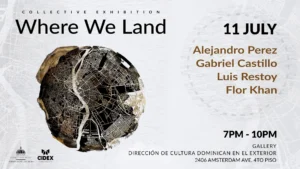In February 2008, I presented my second solo exhibition titled CATARSIS at UNESCO in Santo Domingo. During the opening, my friend Jorge Pineda attended to support me. That same year, between October and December, Damien Hirst exhibited his famous work “For the Love of God” at the Rijksmuseum in Amsterdam. This event generated public controversy that resonated throughout the contemporary art world.
I remember that at the Museum of Modern Art in Santo Domingo, I met with Jorge again, and we discussed Adorno, Benjamin, and Hirst, reflecting on their effectiveness as provocateurs in the artistic sphere. Hirst had placed his skull, encrusted with diamonds, alongside an exhibition of paintings from the museum’s collection, which he had selected and curated himself. This strategy not only emphasized his role as an artist but also invited the viewer to question the relationship between art and consumer culture.
“For the Love of God,” created in 2007, is a life-sized skull made of platinum and adorned with 8,601 diamonds. Since its debut, it has sparked both controversy and admiration, symbolizing extreme luxury and the fragility of human life. Through this work, Hirst challenges our perceptions of material and spiritual value.
The skull, a universal symbol of mortality, reminds us of the inevitability of death. However, by covering it with diamonds, Hirst establishes a tension between beauty and decay. This fusion suggests that despite material wealth, death is an experience shared by all, regardless of social status.
In a world obsessed with the accumulation of goods, Hirst critiques consumerism. The skull becomes a metaphor for the superficial value we assign to objects. The piece challenges the viewer to question what is truly valuable: the diamonds and gold, or life itself?
The execution of “For the Love of God” is impressive. Hirst combines exceptional craftsmanship with profound concepts, reflecting the essence of contemporary art. This work is not only a visual statement; it also serves as commentary on the current state of art, where concept often eclipses technical skill.
The reception of the piece has been polarizing. Some consider it an act of genius, while others see it as mere provocation. This debate reflects the nature of contemporary art, which seeks to discomfort and challenge the audience. Hirst invites viewers to engage in a conversation about beauty, death, and value.
“For the Love of God” transcends its appearance as a skull covered in diamonds; it is a profound reflection on the human condition in a consumerist world. Damien Hirst, through this work, reminds us that despite luxuries, we are all destined for the same end. In the context of contemporary art, this piece stands as a symbol of the struggle between the ephemeral and the eternal, the material and the spiritual, inviting us to rethink our priorities and values. Ultimately, Hirst confronts us with the crucial question: what is truly valuable in our lives?









